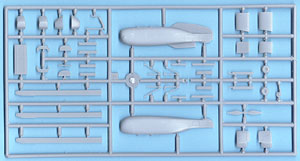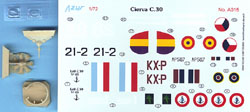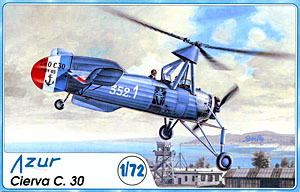Azur’s 1/72 Cierva
C.30 Autogiro By Jim Schubert | | History Senor Juan de la Cierva, a Spanish gentleman from Getafe invented, and patented, the autogyro, he preferred to spell it "Autogiro" - always with a capital "A", shortly after WWI. In the mid 1920s he moved to the UK where funding for his work was more readily obtainable. In the UK his designs progressed from the, Avro 504K based model C.6 to the model C.40. The C.30 and C.40 were designed, in the mid '30s, to Air Ministry Specifications 16/35 and 2/36 respectively. The C.30, intended to be a civil machine, was licensed by Cierva to Avro in the UK, Kellett in the US, Leo et Olivier (LeO) in France and Kayaba in Japan. There is an immediately recognizable similarity amongst all these different interpretations of Cierva's design. The kit subject, the Avro Rota I, was powered by an Armstrong-Siddeley 135 HP Genet Major seven cylinder radial engine, which has its "horse-collar" exhaust collector at the rear.. The lift producing rotor, or rotary wing, of an autogyro is unpowered. It is rotated only by propwash from the conventionally mounted engine and propeller when the aircraft is stationary. An autogyro must make a ground run to accelerate the rotor to flying RPM for takeoff. In flight the rotor is spun by the slipstream produced by movement through the air. The C.30, and many other autogyros, had a drive shaft from a gearbox below the rotor head connected to a power takeoff in the accessories section of the engine by a clutch. This permitted the pilot to engage the clutch and "pre-rotate" the rotor to flying RPM so that the autogyro could make a full power "jump" takeoff. The clutch had to be immediately disengaged after takeoff to avoid a, potentially uncontrollable, torque reaction yawing of the aircraft. As the rotor is unpowered in normal operations, there is no yawing torque reaction and thus no anti-torque tail rotor is required as on a helicopter with its powered rotor. Autogyros can glide, or "auto-rotate", with the engine shut off. The Germans used autogyro kites (actually gliders) towed by submarines to extend their observable horizon for scouting. In an emergency they could be released with the pilot gliding safely to a gentle water landing to be picked up later. The Kit  The instructions would have you believe that you can build a LeO C.30 by simply using the color scheme and markings so nicely displayed in the box art and included on the decal sheet. The LeO built C.30s had three very noticeable differences from the Avro Rota I: They were powered by a nine cylinder 135 HP Salmson 9Nc radial engine, which has its exhaust collector in front of the engine; they had sliding "roll-top desk" like doors on either side of the front cockpit rather than the one hinged door on the left side only of the Avro Rota I; and thirdly, they had a wooden propeller rather than the Avro's forged-twisted Fairey-Reed Aluminum propeller. These are all pretty easy changes to make, but you must make them if you want to use the colorful French markings provided. The very well done box art shows an Avro Rota I incorrectly painted with French colors and markings. The box art also incorrectly shows a hinged door on the right side of the front cockpit. The other three color/markings schemes for the RAF, the Spanish Air Force and the Czechoslovak Air Force are all correct for an Avro Rota I built out-of-the-box. The 42 grey plastic parts are all on one sprue tree. A resin engine, exhaust collector and rotor head are provided along with two vac-formed windscreens. The attractive decal sheet with markings for the four aircraft noted is very well printed by Cartograf. The instructions are on two A-4 sheets printed on both sides plus a half A-4 sheet printed on one side, the lot being folded to create a The instructions would have you believe that you can build a LeO C.30 by simply using the color scheme and markings so nicely displayed in the box art and included on the decal sheet. The LeO built C.30s had three very noticeable differences from the Avro Rota I: They were powered by a nine cylinder 135 HP Salmson 9Nc radial engine, which has its exhaust collector in front of the engine; they had sliding "roll-top desk" like doors on either side of the front cockpit rather than the one hinged door on the left side only of the Avro Rota I; and thirdly, they had a wooden propeller rather than the Avro's forged-twisted Fairey-Reed Aluminum propeller. These are all pretty easy changes to make, but you must make them if you want to use the colorful French markings provided. The very well done box art shows an Avro Rota I incorrectly painted with French colors and markings. The box art also incorrectly shows a hinged door on the right side of the front cockpit. The other three color/markings schemes for the RAF, the Spanish Air Force and the Czechoslovak Air Force are all correct for an Avro Rota I built out-of-the-box. The 42 grey plastic parts are all on one sprue tree. A resin engine, exhaust collector and rotor head are provided along with two vac-formed windscreens. The attractive decal sheet with markings for the four aircraft noted is very well printed by Cartograf. The instructions are on two A-4 sheets printed on both sides plus a half A-4 sheet printed on one side, the lot being folded to create a  nine page guide containing a history in four languages, a parts map, assembly instructions and color/markings drawings. The parts all look good and usable with no warpage or sink marks. My only quibble is with the propeller. It is flat with no discernible airfoil or pitch or the typical Fairey-Reed twist. This should be fairly easy to correct. I also suspect you can find an Aeroclub seven foot Fairey-Reed prop, or cut down a longer one. If you choose to correct the kit prop; remember it is left-handed. If you do the LeO version, its wooden prop is also left-handed. The kit provides a fair interior, but omits the rudders pedals. The SAMI article referenced below has two pages of detail photos of the Avro Rota I in the RAF Museum at Hendon. I would suggest adding the control cables for the rudder and tail wheel and brake hoses for the main wheel brakes to further detail this kit. nine page guide containing a history in four languages, a parts map, assembly instructions and color/markings drawings. The parts all look good and usable with no warpage or sink marks. My only quibble is with the propeller. It is flat with no discernible airfoil or pitch or the typical Fairey-Reed twist. This should be fairly easy to correct. I also suspect you can find an Aeroclub seven foot Fairey-Reed prop, or cut down a longer one. If you choose to correct the kit prop; remember it is left-handed. If you do the LeO version, its wooden prop is also left-handed. The kit provides a fair interior, but omits the rudders pedals. The SAMI article referenced below has two pages of detail photos of the Avro Rota I in the RAF Museum at Hendon. I would suggest adding the control cables for the rudder and tail wheel and brake hoses for the main wheel brakes to further detail this kit.
Conclusion A very nice kit of an interesting, off beat, subject. I'm keen to start on mine. Congratulations to Azur. References Scale Aviation Modeller International (SAMI): October 2000. (Very good build article by the editor, Richard Franks, on the JMGT 48th scale kit of the LeO C.30 with many detail photos of the Avro Rota I) NB I do have more references, but they are not available to me as we have just moved house and they are mostly still in boxes in the garage. Fortunately the SAMI article really gives you all you need to do a great job on either an Avro or LeO built Cierva C.30. | 









    |
